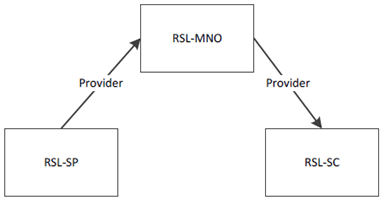Content for TR 28.845 Word version: 18.0.0
1 Scope
2 References
3 Definitions of terms, symbols and abbreviations
3.1 Terms
3.2 Symbols
3.3 Abbreviations
4 Overview
4.1 General
4.2 Business roles
...
...
1 Scope p. 7
The present document studies the charging aspects for Ranging based services and Sidelink Positioning
The following are in the scope:
- Identify the business roles of the Ranging based services and Sidelink Positioning;
- Identify the potential charging scenarios and requirements of the Ranging based services and Sidelink Positioning;
- Identify the potential charging solutions for the Ranging based services and Sidelink Positioning.
2 References p. 7
The following documents contain provisions which, through reference in this text, constitute provisions of the present document.
- References are either specific (identified by date of publication, edition number, version number, etc.) or non-specific.
- For a specific reference, subsequent revisions do not apply.
- For a non-specific reference, the latest version applies. In the case of a reference to a 3GPP document (including a GSM document), a non-specific reference implicitly refers to the latest version of that document in the same Release as the present document.
[1]
TR 21.905: "Vocabulary for 3GPP Specifications".
[2]
TR 23.700-86: "Study on Architecture Enhancement to support Ranging based services and sidelink positioning"
[3]
TS 23.586: "Architectural Enhancements to support Ranging based services and Sidelink Positioning"
[4]
TS 23.273: "5G System (5GS) Location Services (LCS); Stage 2".
[5]
TS 23.501: "System architecture for the 5G System (5GS); Stage 2".
3 Definitions of terms, symbols and abbreviations p. 7
3.1 Terms p. 7
For the purposes of the present document, the terms given in TR 21.905 and the following apply. A term defined in the present document takes precedence over the definition of the same term, if any, in TR 21.905.
Ranging:
Refers to the determination of the distance between two UEs or more UEs and/or the direction of one UE (i.e. Target UE) from another UE (i.e. Reference UE) via PC5 interface.
Sidelink Positioning:
Positioning UE using PC5 to obtain absolute position, relative position, or ranging information.
Target UE:
A UE whose distance, direction and/or position is measured with the support from one or multiple SL Reference UEs using Sidelink in the Ranging based service and Sidelink positioning.
SL Reference UE:
A UE, supporting positioning of target UE, e.g. by transmitting and/or receiving reference signals for positioning, providing positioning-related information, etc. using sidelink.
Located UE:
A SL Reference UE of which the location is known or is able to be known using Uu based positioning. A Located UE can be used to determine the location of a Target UE using Sidelink Positioning.
SL Positioning Client UE:
A UE, other than SL Reference UE and Target UE, which initiates Ranging/Sidelink positioning service request on behalf of the application residing on it.
SL Positioning Server UE:
A UE offering method determination, assistant data distribution and/or location calculation functionalities for Sidelink Positioning and Ranging based service. It interacts with other UEs over PC5 as necessary in order to determine Ranging/SL Position method, distribute assistant data and calculate the location of the Target UE. Target UE or SL Reference UE can act as SL Positioning Server UE if any of the functionalities is supported.
3.2 Symbols p. 8
For the purposes of the present document, the following symbols apply:
3.3 Abbreviations p. 8
For the purposes of the present document, the abbreviations given in TR 21.905 and the following apply. An abbreviation defined in the present document takes precedence over the definition of the same abbreviation, if any, in TR 21.905.
SL
Sidelink Positioning
ProSe
Proximity-based Services
V2X
Vehicle-to-Everything
4 Overview p. 8
4.1 General p. 8
Ranging refers to the process of determining the distance between two or more UEs and/or the direction of one UE from another UE via the PC5 interface. Sidelink Positioning involves obtaining absolute position, relative position or ranging information through the PC5 interface. Ranging-based services and Sidelink Positioning can be widely applied in commercial, V2X and public safety services.
SA2 has completed a study on Ranging based services and Sidelink Positioning (FS_Ranging_SL, TR 23.700-86) and is working on a corresponding work item (Ranging_SL, TS 23.586), which aims to investigate and specify the architecture enhancements to support these services. This study will focus on charging solutions to support Ranging based services and Sidelink Positioning.
4.2 Business roles p. 8
Ranging and Sidelink Positioning involves the services or capabilities may be provided by multiple service providers in the form of following business roles:
- Ranging and Sidelink Positioning Mobile Network Operator (RSL-MNO): an operator who can provide Ranging and Sidelink Positioning services for Ranging and Sidelink Positioning service customer, e.g. 5G MNO.
- Ranging and Sidelink Positioning Service Provider (RSL-SP): a Provider who can provide Ranging and Sidelink Positioning services for RSL-MNO.
- Ranging and Sidelink Positioning Service Customer (RSL-SC): a Customer who is able to consume Ranging and Sidelink Positioning services.

There could be various business models based on the entities with one or several business roles, e.g.:
- B2C: RSL-MNO to charge RSL-SC for using Ranging and Sidelink Positioning services.
- B2B: RSL-SP to charge RSL-MNO for using their devices.